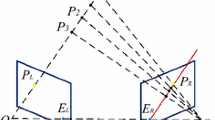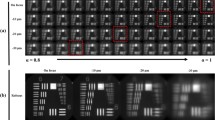Abstract
There are different techniques and devices for visualizing magnetic fields in macro-, micro-, and nanoscale. A non-exhaustive literary overview of macroscale magnetic field visualization methods is presented. Theoretical and experimental techniques are briefly described and contrasted over computational cost, implementation, and usability criterion. Finite element methods (FEM) have a higher computational cost that finite volume methods (FVM) and that meshfree approximation method. Scanning systems have a low computational cost as the input dataset size is small, and there is no need to solve differential equations to reconstruct the fields. Augmented reality (AR) systems have the largest computational cost of all methods. FEM and FVM simulations are simple to implement in 2D and can become quite complex in 3D. All experimental setups are not trivial to build. Scanning systems requires the construction of a linear X, Y mechanical table and a controller design to synchronize sensor readings with probe movement. They are slow, mapping a single surface can take 1 h (Tumanski in Handbook of magnetic measurements (Series inSensors), 1st edn. CRC Press, 2016). Magnetic cameras need hardware design, embedded and application software development. They are simple to use and provide real-time imagery of the field. Finally, AR systems depend on head-mounted devices, 3D FEM models, image processing algorithms to identify fiducials and synchronism of real and virtual objects (Matsutomo et al. in IEEE Trans Magn 53(6):1–4, Article No 8102004, 2017). Despite the high computational cost and the difficulty to build, it provides an immersive interactive experience for the user.
Access this chapter
Tax calculation will be finalised at checkout
Purchases are for personal use only
Similar content being viewed by others
References
Hopster, H., Oepen H. P.: Magnetic Microscopy of Nanostructures. Springer, Berlin (2004)
Meeker, D., Bianchi, N., Gyselinck J., Sabariego R. V., Alberti, L., Pellegrino, G., Cupertino, F.: Electrical machine analysis using free software. IEEE Energy Conversion Congress and Exposition, pp. 1–289 (2017)
Le-Van, V., Meunier, G., Chadebec, O., Guichon, J.: A magnetic vector potential volume integral formulation for nonlinear magnetostatic problems. IEEE Trans. Magn. 52(3), 1–4 (2016)
Lima, E.A., Weiss, B.P.: Obtaining vector magnetic field maps from single-component measurements of geological samples. J. Geophys. Res. 114, B6 (2009)
Ren, Y., Hu, C., Xiang, S., Feng, Z.: Magnetic dipole model in the near-field. In: IEEE International Conference on Information and Automation, Lijiang, pp. 1085–1089 (2015)
Macedo, I., Castro R.: Learning div-free and curl-free vector fields by matrix-valued kernels. Instituto Nacional de Matemática Pura e Aplicada, Preprint serie A679 (2010)
Wahlström, N., Kok, M., Schön, T.B., Gustafsson, F.: Modeling magnetic fields using Gaussian processes. In: IEEE International Conference on Acoustics, Speech and Signal Processing, Vancouver, BC, pp. 3522–3526 (2013)
Jiun-Shyan, C., Michael, H., Sheng-Wei, C.: Meshfree methods: progress made after 20 years. J. Eng. Mech. 143, 04017001 (2017). https://doi.org/10.1061/(ASCE)EM.1943-7889.0001176
Papell, S.S.: Low viscosity magnetic fluid obtained by the colloidal suspension of magnetic particles. US Patent US3215572A (1963)
Henrichsen, K.N.: Overview of magnet measurement methods. CERN, Geneva, Switzerland (1998). https://doi.org/10.5170/CERN-1998-005.127
Tumanski, S.: Modern magnetic field sensors—a review. Przeglad Elektrotechniczny 89, 1–12 (2013)
Wahlström, N., Gustafsson, F.: Magnetometer modeling and validation for tracking metallic targets. IEEE Trans. Signal Process. 62(3), 545–556 (2014)
Nowicki, M., Szewczyk, R.: Ferromagnetic objects magnetovision detection system. Materials (Basel) (2013)
Pasadas, D.J., Ribeiro, A.L., Rocha, T., Ramos, H.G.: 2D surface defect images applying Tikhonov regularized inversion and ECT. NDT & E Int. 80 (2016)
Tumanski, S.: Handbook of Magnetic Measurements (Series inSensors), 1st edn. CRC Press (2016)
Vervaeke, K.: 6D magnetic field distribution measurements of permanent magnets with magnetic field camera scanner. In: 5th International Electric Drives Production Conference (EDPC), Nuremberg, pp. 1–4 (2015)
Metrolab Home page: https://www.metrolab.com/wpcontent/uploads/2015/07/MFC3045_manual_v30_rev10.pdf
Tuan, B.A., de Souza-Daw, A., Phuong, H.M., Hoang, T.M., Dzung, N.T.: Magnetic camera for visualizing magnetic fields of home appliances. In: IEEE Fifth International Conference on Communications and Electronics (ICCE), Danang, pp. 370–375 (2014)
Buchau, A., Rucker, W., Wössner, U., Becker, M.: Augmented reality in teaching of electrodynamics. COMPEL-Int. J. Comput. Math. Electr. Electron. Eng. 28(4), 948–963 (2009)
Matsutomo, S., Manabe, T., Cingoski, V., Noguchi, S.: A computer aided education system based on augmented reality by immersion to 3-D magnetic field. IEEE Trans. Magn. 53(6), 1–4, Article No. 8102004 (2017)
Acknowledgements
Thanks to Ricardo Wandré Dias Pedro for reviewing and providing valuable inputs to this paper on short notice.
Author information
Authors and Affiliations
Corresponding author
Editor information
Editors and Affiliations
Rights and permissions
Copyright information
© 2021 Springer Nature Switzerland AG
About this paper
Cite this paper
Trujilho, L.B., Saotome, O. (2021). An Overview of Magnetic Field Visualization Methods and Applications for Macroscale Objects. In: Iano, Y., Arthur, R., Saotome, O., Kemper, G., Padilha França, R. (eds) Proceedings of the 5th Brazilian Technology Symposium. BTSym 2019. Smart Innovation, Systems and Technologies, vol 201. Springer, Cham. https://doi.org/10.1007/978-3-030-57548-9_27
Download citation
DOI: https://doi.org/10.1007/978-3-030-57548-9_27
Published:
Publisher Name: Springer, Cham
Print ISBN: 978-3-030-57547-2
Online ISBN: 978-3-030-57548-9
eBook Packages: EngineeringEngineering (R0)




